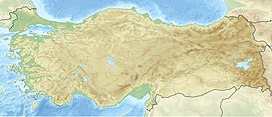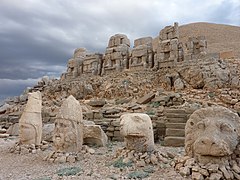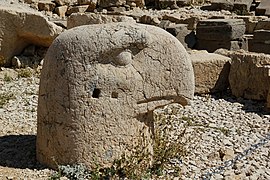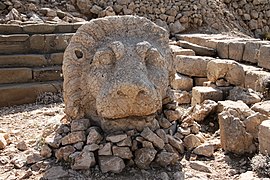Mount Nemrut
| Mount Nemrut | |
|---|---|
 | |
| Highest point | |
| Elevation | 2,134 m (7,001 ft) |
| Coordinates | 37°58′54″N 38°44′28″E / 37.98167°N 38.74111°E |
| Geography | |
Adıyaman Province, Turkey | |
| Official name | Nemrut Dağ |
| Criteria | Cultural: i, iii, iv |
| Reference | 448 |
| Inscription | 1987 (11th Session) |
| Area | 11 ha |
Nemrut or Nemrud (Template:Lang-tr; Template:Lang-ku; Template:Lang-hy) is a 2,134-metre-high (7,001 ft) mountain in southeastern Turkey, notable for the summit where a number of large statues are erected around what is assumed to be a royal tomb from the 1st century BC. It is one of the highest peaks in the east of the Taurus Mountains.
Location and description

The mountain lies 40 km (25 mi) north of Kahta, near Adıyaman. In 62 BCE, King Antiochus I Theos of Commagene built on the mountain top a tomb-sanctuary flanked by huge statues 8–9-metre high (26–30 ft) of himself, two lions, two eagles and various Greek and Iranian gods, such as Heracles-Artagnes-Ares, Zeus-Oromasdes, and Apollo-Mithras-Helios-Hermes.[1][2] These statues were once seated, with names of each god inscribed on them. The heads of the statues at some stage have been removed from their bodies, and they are now scattered throughout the site.
The pattern of damage to the heads (notably to noses) suggests that they were deliberately damaged as a result of iconoclasm. The statues have not been restored to their original positions. The site also preserves stone slabs with bas-relief figures that are thought to have formed a large frieze. These slabs display the ancestors of Antiochus, who included Greeks and Persians.[1]
The same statues and ancestors found throughout the site can also be found on the tumulus at the site, which is 49-metre tall (161 ft) and 152 m (499 ft) in diameter. It is possible that the tumulus of loose rock was built to protect a tomb from robbers, since any excavation would quickly fill in.[3] The statues appear to have Greek-style facial features, but Persian clothing and hair-styling.

The western terrace contains a large slab with a lion, showing an arrangement of stars and the planets Jupiter, Mercury and Mars. The composition was taken to be a chart of the sky on 7 July 62 BCE.[4] This may be an indication of when construction began on this monument. The eastern portion is well preserved, being composed of several layers of rock, and a path following the base of the mountain is evidence of a walled passageway linking the eastern and western terraces. Possible uses for this site are thought to have included religious ceremonies, owing to the astronomical and religious nature of the monument.
The arrangement of such statues is known by the term hierothesion. Similar arrangements have been found at Arsameia on Nymphaios at the hierothesion of Mithridates I Callinicus, the father of Antiochus.
Ancient history
When the Seleucid Empire was defeated by the Romans in 190 BC at the Battle of Magnesia it began to fall apart and new kingdoms were established on its territory by local authorities. Commagene, one of the Seleucid successor states, occupied a land between the Taurus mountains and the Euphrates. The state of Commagene had a wide range of cultures which left its leader from 62 BC – 38 BC Antiochus I Theos to carry on a peculiar dynastic religious program, which included not only Greek and Iranian deities but Antiochus and his family as well. This religious program was very possibly an attempt by Antiochus to unify his multiethnic kingdom and secure his dynasty's authority.[5]
Antiochus supported the cult as a propagator of happiness and salvation.[6] Many of the ruins on Mount Nemrud are monuments of the imperial cult of Commagene. The most important area to the cult was the tomb of Antiochus I, which was decorated with colossal statues made of limestone. Although the imperial cult did not last long after Antiochus, several of his successors had their own tombs built on Mount Nemrud.[7] For around half of the year, Mount Nemrud is covered in snow, the effect of which increases weathering, which has in part caused the statues to fall in ruin.[5]
Modern history
The site was excavated in 1881 by Karl Sester, a German engineer assessing transport routes for the Ottomans. After her first visit in 1947, Theresa Goell dedicated her life to the site, starting campaigns in 1954. Subsequent excavations have failed to reveal the tomb of Antiochus. This is nevertheless still believed to be the site of his burial. The statues, all of them "beheaded", have not been restored to their original condition.
World Heritage Site
In 1987, Mount Nemrut was made a World Heritage Site by UNESCO.[8] Tourists typically visit Nemrut during April through October. The nearby town of Adıyaman is a popular place for car and bus trips to the site, and one can also travel from there by helicopter. There are also overnight tours running out of Malatya or Kahta.[9]
Gallery
-
Mount Nemrut
-
East Terrace
-
Mount Nemrut
-
Heads of statues
-
Heads of statues
-
East Terrace
-
East Terrace
-
West Terrace
-
East Terrace: Thrones
-
East Terrace: Heads of Antiochus I Theos and Heracles Artagnes Ares
-
West Terrace: Head of Apollo/Mithra/Helios/Hermes
-
East Terrace: Head of Apollon
-
West Terrace: Zeus Oromasdes
-
West Terrace: Heracles Artagnes Ares
-
West Terrace: Head of Goddess of Kommagene (Tyche)
-
West Terrace: Head of Persian Eagle God
-
East Terrace: Lion head
-
West Terrace: Eagle and Lion from sandstones
-
West Terrace: Sandstone Stele / Stelae of Persian
See also
- Cities of the ancient Near East
- Gods
- List of megalithic sites
- Queen of the Mountain—a documentary about the excavation of Mount Nemrut
References
- ^ a b Widengren 1986, pp. 135–136.
- ^ Shayegan 2016, p. 13.
- ^ Hewsen, Robert H. (2001). Armenia: A historical Atlas. p. 42.
- ^ Neugebauer, O.; van Hoessen, H.B. (1959). "Greek horoscopes". Memoirs of the American Philosophical Society. xlviii. Philadelphia: 14–16.
The authors chose that date in preference to 23 July 49 BCE which other researchers prefer, see
Belmonte, Juan Antonio; Gonzales-Garcia, A. César (2010). "Antiochos's hierothesion at Nemrud Dag revisited: Adjusting the date in the light of astronomical evidence" (PDF). J. Hist. Astronomy. 41. - ^ a b Siliotti 2006, p. 217
- ^ Siliotti 2006, p. 218
- ^ Siliotti 2006, p. 220
- ^ Giorgio Lollino; Andrea Manconi; Fausto Guzzetti; Martin Culshaw; Peter Bobrowsky; Fabio Luino, eds. (2014). Engineering Geology for Society and Territory - Volume 5: Urban Geology, Sustainable Planning and Landscape Exploitation (illustrated ed.). Springer. p. 45. ISBN 9783319090481.
- ^ Patricia Erfurt-Cooper, ed. (2014). Volcanic Tourist Destinations; Geoheritage, Geoparks and Geotourism (illustrated ed.). Springer Science & Business Media. p. 93. ISBN 9783642161919.
Sources
- Shayegan, M. Rahim (2016). "The Arsacids and Commagene". In Curtis, Vesta Sarkhosh; Pendleton, Elizabeth J.; Alram, Michael; Daryaee, Touraj (eds.). The Parthian and Early Sasanian Empires: Adaptation and Expansion. Oxbow Books. ISBN 9781785702082.
{{cite book}}: Invalid|ref=harv(help) - Widengren, G. (1986). "Antiochus of Commagene". Encyclopaedia Iranica, Vol. II, Fasc. 2. pp. 135–136.
{{cite encyclopedia}}: Invalid|ref=harv(help) - Siliotti, Alberto (2006), Hidden Treasures of Antiquity, Vercelli: VMB, ISBN 88-540-0497-9
- Brijder, Herman A.G. (ed.) (2014), Nemrud Dağı: Recent Archaeological Research and Conservation Activities in the Tomb Sanctuary on Mount Nemrud. Walter de Gruyter, Boston/Berlin, ISBN 978-1-61451-713-9.
External links
- Jacobs, Bruno (2011). "NEMRUD DAĞI". Encyclopaedia Iranica.
{{cite encyclopedia}}: Invalid|ref=harv(help) - Mt. Nemrut
- International Nemrud Foundation
- Commagene Nemrut Conservation and Development Program




















